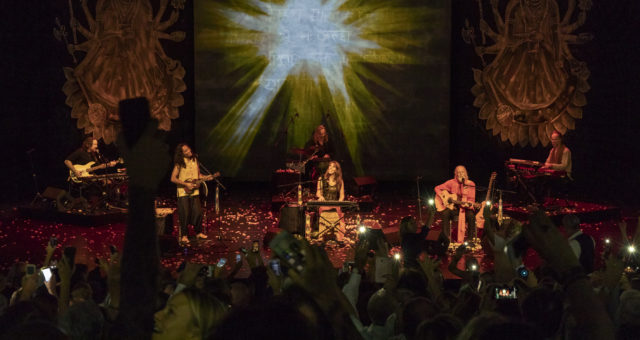
Twelve years ago, when we last caught up to Deva Premal and Miten, they had just finished a chant workshop in upstate New York and were preparing to head west on tour, including a stop at Chautauqua. They were leading something of a nomadic life, bringing their mantra and song performances to studios and theaters across the globe, and they became, quite unintentionally, leaders in the global chant movement.
“At some point,” Premal told us at the time, “we may say, ‘OK, take a break.’ But not yet.”
Well, as Miten explained in an interview last week, an extended break for the musical and life partners still hasn’t quite presented itself, with a notable exception.
“Actually, we’ve only missed two days’ work in 28 years… and one of those was for an open heart operation,” he laughs.
“Is it a struggle?” responds Premal. “Actually, it never feels like a struggle. We always feel like we’re supported. We know how to pace ourselves. We make our own schedule, we know what feels good, we know our own rhythm. We’re in a good place.”
“Y’know,” reflects Miten, “to some people it does sound crazy, the way we work and the way we live. We’ve never bothered to have a home or a base, in 28 years. We’ve just been on the road. We like it like that.
“It’s just been great watching the whole movement expand and crystallize. It’s just been beautiful.”
The pair met almost 30 years ago at the meditation center of Bhagwan Shree Rajneesh (known to his followers as Osho), where Miten, having thrown off the life of a successful British rock musician in search of spiritual substance, and Premal, who had been exposed to ancient chant and related spiritual disciplines as a child, found common passion in ancient mantra. Premal’s experience extended well before her time at the ashram — she was actually birthed to the sound of the Gayatri Mantra (from the ancient Hindu text Rig Veda, circa 1700 B.C.) and grew up hearing it as a lullaby.
Along with the esteemed Nepalese flautist Manose and a small band of Western musicians, Deva and Miten’s performances — and they’re a little cautious about characterizing their events thusly — feature both more Western tradition songsmithing of Miten’s, as well as ensemble renditions of Sanskrit and Hindu mantra. Some of these vocal pieces are 4,000 years old and we wondered about how one approaches rendering them in a modern context. Their website, for example, includes tabs and chordal arrangements behind them, as performed by them. It’s a stretch to imagine how the composers of these pieces would have imagined a D minor chord strummed on an acoustic guitar as accompaniment.
Miten points to Osho’s attitudes toward originalism.
“The mantras themselves are powerful beings, they’re energetic entities. My understanding of them is that there must have been people around — scientists — with the same understanding or the same feeling as any modern day person, of exploration. What is sound? (Can you imagine what sound was like 5,000 years ago?) And they were interested in exploring how sound affects us. And that’s how they came into being… like scientifically discovered sound formulas.
“It’s a matter of taste, really,” he continues. “Our taste is what we put out and what we play; it’s not everybody’s taste. [With respect to Osho], he wasn’t a traditionalist, he wasn’t interested in encouraging us to play kirtan or harmonium or any of that stuff. He was more open to, ‘Play your music.’ We played a huge variety of music that, in some ways, paralleled Osho’s discourses. In some ways, we had our perspectives blown open, we were playing even samba in the meditation rooms, with Osho coming out and dancing with us. That’s very unique, having a guru coming out to dance with his disciples.”
“The basic thing is to find a way to make sing-able without simplifying the melodies too much,” Premal adds. “We also take great care that the style that we put the mantras in enhances the feeling of the mantras. That it doesn’t detract or distract. It’s such a fine line. We like a jazz influence, because jazz has such an open flavor, with the chords being so multi-faceted. You can hear the influence on some of the recordings we have done.”
To someone grounded in Western musical tradition, and more narrowly in the popular music performance space — audiences come to hear an artist perform their art, and each individual responds according to their own perspective and aesthetic inclinations — Premal and Miten are keen to remind that their events are more grounded in the communal exercise of mantra, and that they themselves are not so much performers as conduits. This is either an esoteric distinction, or a simple one. To the extent that their fans come to experience one of their events, they are participants, as are the principals.
“I feel like we are there for people who are already looking deeper,” Premal says. “We’re not there to preach, we’re not really on a mission. If this is what you love and what you enjoy, here we are, and we will contribute with the utmost care. Everything we do — the way we design the evening, the musicians — is to answer the calling for the people who know what they want.”
We couldn’t resist asking if either had any musical guilty pleasures. Premal demurred on that, but Miten drew a mildly mischievous breath and starting singing…
“Tell me somethin’ girl/Are ya’ happy in this modern world?”
“That’s my guilty pleasure. I’ve fallen in love with Ally, from A Star is Born. Otherwise known as Lady Gaga. What a great movie, and what a great girl. I think she’s fantastic.”
ON THE BILL: Deva Premal and Miten — with Manose. 7:30 p.m. Thursday, May 2, Boulder Theater, 2032 14th St., Boulder,
bouldertheater.com. Tickets are $35-$108.














